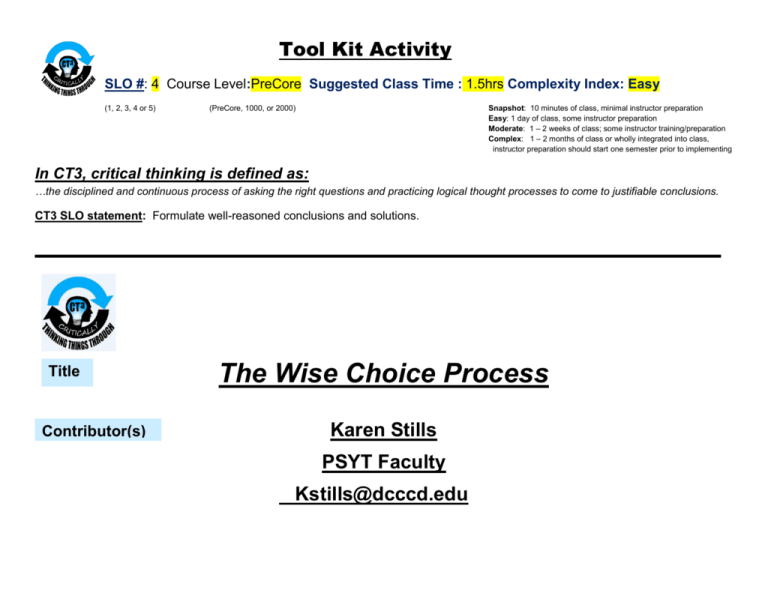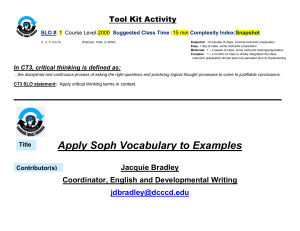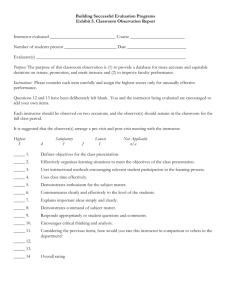Tool Kit Activity - El Centro College
advertisement

Tool Kit Activity SLO #: 4 Course Level:PreCore Suggested Class Time : 1.5hrs Complexity Index: Easy (1, 2, 3, 4 or 5) (PreCore, 1000, or 2000) Snapshot: 10 minutes of class, minimal instructor preparation Easy: 1 day of class, some instructor preparation Moderate: 1 – 2 weeks of class; some instructor training/preparation Complex: 1 – 2 months of class or wholly integrated into class, instructor preparation should start one semester prior to implementing In CT3, critical thinking is defined as: …the disciplined and continuous process of asking the right questions and practicing logical thought processes to come to justifiable conclusions. CT3 SLO statement: Formulate well-reasoned conclusions and solutions. Title Contributor(s) The Wise Choice Process Karen Stills PSYT Faculty Kstills@dcccd.edu Tool Kit Activity :_The Wise Choice Process_ SLO #: _4__ Tier:___PC___ (1, 2, 3, 4 or 5) Suggested Class Time :__1.5 hrs___ Complexity Index:_Easy_ (PreCore, 1000, or Soph) Snapshot: 10 minutes of class, minimal instructor preparation Easy: 1 day of class, some instructor preparation Moderate: 1 – 2 weeks of class; some instructor training/preparation Complex: 1 – 2 months of class or wholly integrated into class, instructor preparation should start one semester prior to implementing In CT3, critical thinking is defined as: …the disciplined and continuous process of asking the right questions and practicing logical thought processes to come to justifiable conclusions. CT3 SLO statement: Students who participate in this activity will be able to formulate well reasoned conclusions and solutions. Objective of Activity: The Wise Choice Process is a tool designed to assist students in problem solving and decision making, by applying a set of six questions to existing problems or situations that are not yielding desired results. Students must ask themselves and respond to the following questions: 1. 2. 3. 4. 5. 6. What is the current situation/problem? How would you like your situation to be? What are all of your possible choices? What are the likely outcomes of each possible choice? What choices are you willing to commit to? When will you evaluate the choice/decision that you made? Activity Description: 1. Mini Lecture on Personal Responsibility, Power of Choice, brief overview of the Wise Choice Process. (15 min) 2. Students Divide into groups of 3-4 to read and discuss a case study highlighting a college student who is struggling in his/her classes because of various obstacles, and is contemplating dropping courses. **Note…this case study can be adapted/re-written to reflect a situation/problem that is relevant to any particular course. (10 min) 3. Groups will be presented with the six questions that are a part of the Wise Choice Process: What is the current situation/problem? How would you like your situation to be? What are all of your possible choices? What are the likely outcomes of each possible choice? What choices are you willing to commit to? When will you evaluate the choice/decision that you made? 4. Using the information from the case study, students are asked to brainstorm for each question . A group selected scribe will take notes and a selected speaker will share the group’s discussion and responses. (20 min) 5. After returning to their own space, students will be asked to write an in-class journal that calls for them to identify their own problem or situation that they are experiencing and apply the Wise Choice Process in coming up with possible solutions. A final question will ask each student, what they feel they have learned from using the Wise Choice Process. (20 min) 6. Recap over the 6 Questions of the Wise Choice Process and their relevance to decision making and answer any questions. (15 minutes) Web Pages for Instructor Preparation for Activity: n/a Web Pages to Access During Activity: n/a Suggested Assessment Technique(s): Students will provide written work that demonstrates their use/application of the Wise Choice process to a situation or problem. The rubric provided below should be used to evaluate responses. Using the rubric to assess the assignment is a direct measurement of student learning for the identified SLO. The written journal responses and the correlating graded rubrics will be the collected samples of evidence. Student’s Name: ______________________________________ Student ID: ___________________ Check the box that best demonstrates the student’s ability to problem-solve a difficult situation. WISE CHOICE PROCESS Unsatisfactory (Below Standard) Satisfactory Proficient (Met Criteria ) (Above Criteria) Define Problem “What is my present situation?” Demonstrates a limited ability in identifying a problem statement or related contextual factors Demonstrates the ability to construct a problem statement with evidence of most relevant contextual factors, but problem statement is superficial Demonstrates the ability to construct a problem statement with evidence of most relevant contextual factors, and problem statement is adequately detailed Identify Strategies “What are my possible choices?” Identifies one or more approaches for solving the problem that do not apply within a specific context Identifies only a single approach for solving the problem that does apply within a specific context. Identifies multiple approaches for solving the problem, only some of which apply within a specific context Evaluate Potential Solutions “What is the likely outcome of each possible choice?” Evaluation of solutions is superficial (for example, contains cursory, surface level explanation) Evaluation of solutions is brief (for example, explanation lacks depth) and includes the following: considers history of problem, reviews logic/reasoning, examines feasibility of solution, and weighs impacts of solution. Evaluation of solutions contains thorough explanation and includes the following: considers history of problem, reviews logic/reasoning, examines feasibility of solution, and weighs impacts of solution. Propose Solutions “What choice will I commit to doing?” Proposes a solution that is difficult to evaluate because it is vague or irrelevant Proposes one solution that is “generic” rather than individually designed to address the specific contextual factors of the problem Proposes one or more solutions that indicates comprehension of the problem; Solutions address the context of the problem Evaluate Outcomes “When and how will I evaluate my plan?” Indicates no consideration of need for the plan to be evaluated Mentions the need for the plan to be evaluated, but does not include any additional details Clearly identifies the date and criteria by which the plan will be evaluated Rubric modified from AAC&U’s Problem-Solving VALUE Rubric Contributor(s) Citation and Bibliographic References: Submitted by Karen Stills, PSYT Adjunct Faculty, kstills@dcccd.edu Work adapted from Downing, S. (2011). On course (6th ed.). Australia: Wadworth Cengage Learning.





